| dc.contributor.author | Westereng, Bjørge | |
| dc.contributor.author | Kračun, SK | |
| dc.contributor.author | Leivers, Shaun Allan | |
| dc.contributor.author | Arntzen, Magnus Øverlie | |
| dc.contributor.author | Aachmann, Finn Lillelund | |
| dc.contributor.author | Eijsink, Vincent | |
| dc.date.accessioned | 2021-01-26T09:47:42Z | |
| dc.date.available | 2021-01-26T09:47:42Z | |
| dc.date.created | 2020-10-02T14:17:48Z | |
| dc.date.issued | 2020 | |
| dc.identifier.citation | Scientific Reports. 2020, 10, . | en_US |
| dc.identifier.issn | 2045-2322 | |
| dc.identifier.uri | https://hdl.handle.net/11250/2724725 | |
| dc.description.abstract | Polysaccharides from plant biomass are the most abundant renewable chemicals on Earth and can potentially be converted to a wide variety of useful glycoconjugates. Potential applications of glycoconjugates include therapeutics and drug delivery, vaccine development and as fine chemicals. While anomeric hydroxyl groups of carbohydrates are amenable to a variety of useful chemical modifications, selective cross-coupling to non-reducing ends has remained challenging. Several lytic polysaccharide monooxygenases (LPMOs), powerful enzymes known for their application in cellulose degradation, specifically oxidize non-reducing ends, introducing carbonyl groups that can be utilized for chemical coupling. This study provides a simple and highly specific approach to produce oxime-based glycoconjugates from LPMO-functionalized oligosaccharides. The products are evaluated by HPLC, mass spectrometry and NMR. Furthermore, we demonstrate potential biodegradability of these glycoconjugates using selective enzymes. | en_US |
| dc.language.iso | eng | en_US |
| dc.publisher | Nature Research | en_US |
| dc.rights | Navngivelse 4.0 Internasjonal | * |
| dc.rights.uri | http://creativecommons.org/licenses/by/4.0/deed.no | * |
| dc.title | Synthesis of glycoconjugates utilizing the regioselectivity of a lytic polysaccharide monooxygenase | en_US |
| dc.type | Peer reviewed | en_US |
| dc.type | Journal article | en_US |
| dc.description.version | publishedVersion | en_US |
| dc.source.volume | 10 | en_US |
| dc.source.journal | Scientific Reports | en_US |
| dc.identifier.doi | 10.1038/s41598-020-69951-7 | |
| dc.identifier.cristin | 1836620 | |
| dc.relation.project | Norges forskningsråd: 244259 | en_US |
| dc.relation.project | Norges forskningsråd: 221576 | en_US |
| dc.relation.project | Norges forskningsråd: 226244 | en_US |
| dc.relation.project | Norges forskningsråd: 214613 | en_US |
| dc.description.localcode | This article is licensed under a Creative Commons Attribution 4.0 International License, which permits use, sharing, adaptation, distribution and reproduction in any medium or format, as long as you give appropriate credit to the original author(s) and the source, provide a link to the Creative Commons license, and indicate if changes were made. The images or other third party material in this article are included in the article’s Creative Commons license, unless indicated otherwise in a credit line to the material. If material is not included in the article’s Creative Commons license and your intended use is not permitted by statutory regulation or exceeds the permitted use, you will need to obtain permission directly from the copyright holder. To view a copy of this license, visit http://creativecommons.org/licenses/by/4.0/. | en_US |
| dc.source.articlenumber | 13197 | en_US |
| cristin.ispublished | true | |
| cristin.fulltext | original | |
| cristin.qualitycode | 1 | |

